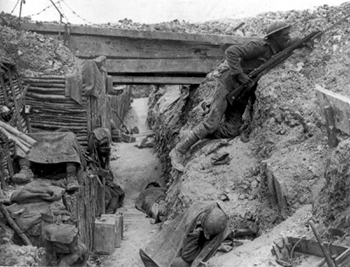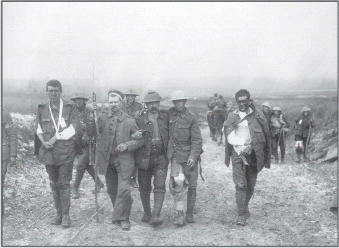Joffre demanded that Haig open up the new offensive on the Somme to take the pressure of his beleaguered men at Verdun. Haig, concerned that the new recruits to the British army were not yet battle-ready, offered 15 August as a start date. Joffre responded angrily that the French army would ‘cease to exist’ by then. Haig brought forward the offer to 1 July.

German infantry advancing during the Battle of Verdun, 1916
During June, the attack and counter-attack at Verdun continued. On the Eastern Front, the Russian general, Aleksei Brusilov, attacked the Austrians, who in turn, appealed to Falkenhayn for help. Falkenhayn responded by calling a temporary halt at Verdun and transferring men east. The Battle of Verdun wound down, then fizzled out entirely. The French, under the stewardship of Nivelle regained much of what they had lost. After ten months of fighting, the city had been flattened, and the Germans and French, between them, had lost 260,000 men – one death for every ninety seconds of the battle.
The Russians, in what became known as the Brusilov Offensive, shattered the Austrian army to an extent it never fully recovered. With Falkenhayn’s Germans coming, Brusilov called for reinforcements of his own – but none came. Brusilov’s success against the Austrians was countered by his defeat to the Germans.
Trenches
By 1916, the trench system had become a fixed and elaborate aspect of the war in the west. Front-line trenches were backed by reserve and support lines and consisted of underground bunkers. Life in the trenches became a routine of filth, lice, rats, cold, deprivation, and boredom punctuated with moments of terror. Weeks of living in mud often resulted in trench foot. The German, content to secure their defensive positions, built more sophisticated trenches that were deeper, more secure, warmer and, in some instances, boasted electricity. For the Allies, determined to rid the German foe from French or Belgium soil, the trenches were only ever meant to be a temporary improvisation.

British soldier during the Battle of the Somme, July 1916
IWM Collections, Q 3990
The system always favoured defence as was shown time and again throughout the war. Generals, planning their advances, continued to advocate the use of preliminary artillery to pound the enemy’s trenches and flatten its barbed wire. Then, having pulverized the enemy’s front line, infantry could advance across the expanse of No Man’s Land, typically between 100 and 400 metres wide, and engage the enemy, finishing him off by bayonet.
The reality always proved otherwise. The artillery, however sustained, rarely did more than limited damage either to trench or manpower. Men, on the receiving end of artillery, would simply disappear underground into the concreted bunkers only to re-emerge as the infantry approached, and mow them down with machine-gun fire. The gains, if any, were usually minimal, soon reversed and came at a high cost.
The cost on the minds and shattered nerves of the men was also high. Combat stress, or ‘shellshock’, became a common occurrence. Sympathy for these non-visible wounds was not always forthcoming, especially during the early stages of the war. 80,000 British servicemen – 2 per cent of those who saw active service – suffered from forms of shellshock. Men, were so traumatized, they would forget their own names. For many, unable to cope, running away seemed the only option. The risk was high – the French executed over 600 men for desertion or cowardice, the British and Commonwealth 306, and Germany 18. The US sentenced 24 to death but no executions were carried out.

Wounded British soldiers, Battle of the Somme, July 1916
IWM Collections, Q800
The Battle of the Somme started with the usual preliminary bombardment. Lasting five days, and involving 1,350 guns, soldiers were assured that the eighteen-mile German front line would be flattened – it would just be a matter of strolling across and taking possession of the German trenches – beyond that, lay Berlin.
The British army at the Somme consisted mainly of Kitchener recruits, who had received only minimal training, and were to cross No Man’s Land lumbered with almost 70 lbs of equipment. The advance started at 7.30 a.m.
1 comment